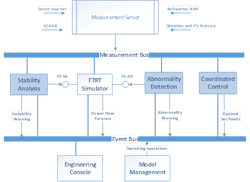Using Modeling and Simulation to Support Grid Resiliency
Our industry has long used modeling and simulation to support various planning and operational functions. Simulation is used for training control room operators and is now seeing increased use by planners to predict the future state of the grid under high penetration distributed energy resources (DERs).
Combining modeling and simulation with real-time operating data is the basis of the latest U.S. Department of Energy (DOE) Solar Energy and Technologies Office (SETO) project that expects to better flag abnormalities than pure operational data alone. At least that is the hypothesis of the three-year project led by Electrical Distribution Design (EDD) Inc. The project team also includes utility PEPCO Holdings (PHI), and technology/research providers Clean Power Research (CPR), Florida State University (FSU), Smart Electric Power Alliance (SEPA), University of Delaware (UD), Dominion Voltage Inc. (DVI), and KITU Systems.
The transition to an increasingly renewable-based electric grid will require replacing large centralized rotating generators with smaller, solid-state inverter-based generators. However, increasing levels of variable renewable generation bring major challenges for power system operations, especially around stability and security at the grid edge. Recent studies on the benefits of 'smart' inverters, both with or without energy storage, have thrown light on their value, especially for grids with high penetration of PV. Smart inverters have several new features that enable higher concentration of distributed PV systems without creating instability. For example, a smart inverter can adjust its real or reactive power or voltage to support the local grid voltage or frequency.
DOE Project Status
PV power generation is variable and strongly dependent on cloud cover. This variability contributes to some uncertainty in power flow and quality on the distribution grid. Thus, determining weather and PV production for real-time and future horizons is an increasingly important component of the developed system. Under this project, the PHI will be provided with the intelligence needed for detecting abnormalities and managing voltage stability with rapidly changing generation.
"This project focuses on solving the core challenges associated with energy transition — digitalization, decarbonization, and decentralization," said Skip Dise, VP of product management at the CPR.
Over the last several months, the CPR has worked with the EDD and the PHI to integrate this design system with the PHI's DER system of record. The CPR has provided a software platform to enumerate all the rooftop solar and generate historical, real-time, and forecast power outputs using irradiance models and PV power models. This solution will use advanced minute-by-minute behind-the-meter prediction and forecasting that will make it easier for the EDD and the PHI to estimate the state of the distribution grid.
"The importance of the irradiance data has been a big lesson learned thus far," said Robert Broadwater, EDD and project principal investigator.
The EDD is incorporating irradiance data and variability statistics into its full model and simulation. With highly loaded feeders, the team has learned that the prediction of load has a high sensitivity to irradiance, which helps to predict the load on the system. The project will use irradiance variability statistics in decisions on inverter control strategies, where the control is balancing maximum power production versus voltage control.
In its first year, the project team is quality checking the models against operational data, as well as scoping and integrating data from various systems. The project involves a number of different systems, such as supervisory control and data acquisition (SCADA), advanced metering infrastructure (AMI), weather forecast, geographic information system (GIS), and so forth — 10 systems in total.
In year three, teams will build and field test new models to demonstrate the capability to predict abnormalities quicker than traditional analysis using operational data. By creating a single view of system operations, from transmission to secondary distribution, the system will be able to detect operational abnormalities, identify and mitigate voltage instabilities, and coordinate control between smart inverters and utility control devices.
One lesson learned thus far is that there isn't always a standard use of data elements and accurate data information on secondaries. As a result, data cleansing and preparation has been a challenge.
"Cleaning up the various layers of data to make a meter to substation model really accurate has been quite challenging at times. However, we are looking at all of the analytical means and benefits, and for the couple sample feeders, we resorted to field checks to resolve discrepancies between the draft model and as-built conditions. This has really highlighted the importance of data integrity in the forefront of advanced power flow programs," said Luan Watson, capacity planning engineer, PHI.
Using graph trace analysis, a technique the EDD has developed, the project team will provide the ability to accurately model transmission to every home or business. This isn't done today because of existing grid model challenges, as well as the computational power required. The methods and models used in this project will demonstrate that it is indeed possible to accurately run models and eventually use machine learning to inform the models of field changes.
Measurement and Model Integrator
Thus far, the project has produced several use cases for utility operators of the combined solution, named the Measurement and Model Integrator for Ensuring Grid Security (M2 IEGS) system (see Fig. 1). There are four main functionalities of the M2 IEGS system: weather-based load forecasting that incorporates a short-term PV forecast, abnormality detection, voltage stability tracking, and hierarchical coordinated control scheduling.
The research will demonstrate on three radial feeders from the utility and some secondary circuits. These feeder models are integrated with the transmission model. The transmission model has three voltage levels: 69 kV, 138 kV, and 230 kV, with 1500 MW total load and 37 loops. This transmission model is merged into the substation and primary/secondary models described above to form a transmission + substation + distribution primary + secondary (TSDS) model.
What's Next?
Once the systems are fully integrated, the team will begin simulations to detect control abnormalities or cyberattacks. A key output this year will be a demonstration that the computational speed of the functionality and model are sufficient to begin phase two of the project, which entails moving to laboratory and hardware-in-the-loop simulation before ultimately going to field demonstration in year three.
About the Author
Sharon Allan
Sharon Allan is Smart Electric Power Alliance's (SEPA) chief strategy and innovation officer, providing leadership and strategic direction, addressing the transformation of the energy sector. She has advised corporate boards, Fortune 100 companies, venture and private equity companies, as well as the U.S. Department of Energy (DOE), the U.S. National Institute of Standards & Technology, and many U.S. National Laboratories.
Prior to joining the SEPA, Allan held roles as the CEO of the Smart Grid Interoperability Panel, managing director/partner, Accenture, president, Elster Integrated Solutions as well as executive roles at ABB. She currently sits on the advisory board of Enertech Capital. She holds a BS degree in electrical engineering from the University of Florida and a masters degree in business administration from the Duke University Fuqua Business School.


